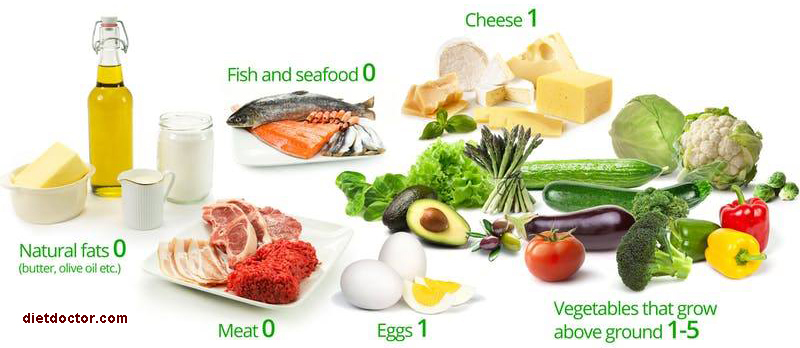It’s fascinating to note that while the ketogenic diet has garnered immense popularity for its low-carb, high-fat approach, there’s a subtle but crucial distinction worth understanding: Is it inherently gluten-free? Many adherents of keto revel in the elimination of wheat-based products, which seems to naturally align with a gluten-free lifestyle. However, the answer is not as straightforward as one might think.
Historical aspects show that the keto diet’s primary focus is on limiting carbohydrate intake to attain ketosis, rather than eliminating gluten specifically. Interestingly, many keto-friendly foods—such as non-starchy vegetables, meats, and healthy fats—are naturally gluten-free, providing a significant overlap. Nevertheless, caution should be exercised as certain processed keto products may contain hidden gluten, emphasizing the need for vigilance among gluten-sensitive individuals.

Understanding the Keto Diet
The ketogenic diet, or keto for short, is a low-carb, high-fat diet. Its main goal is to make the body enter a state called ketosis. In ketosis, the body burns fat for energy instead of carbs.
To reach ketosis, most people reduce their carbohydrate intake to around 20-50 grams per day. Instead, they consume plenty of fats and moderate protein. This shift helps the body switch its fuel source from glucose to ketones.
Common foods on the keto diet include meat, fish, eggs, cheese, and non-starchy vegetables. Foods high in sugar or carbs, like bread and pasta, are typically avoided. This can contribute to weight loss and improved energy levels.
Many find the keto diet easy to follow because it includes a lot of satisfying foods. However, it’s important to plan meals carefully to ensure you’re getting all necessary nutrients. Consulting with a dietitian can be beneficial for long-term success.
The Glutinous Matter: Is Keto Gluten-Free by Nature?
The keto diet focuses on low-carb, high-fat foods, which often means eliminating many traditional sources of gluten. However, this doesn’t guarantee that all keto foods are gluten-free. Many naturally keto-friendly foods, like meats and vegetables, do not contain gluten.
Natural Overlap between Keto and Gluten-Free
Keto and gluten-free diets both exclude grains like wheat, barley, and rye. As a result, there’s a significant overlap between the two. For those who must avoid gluten due to celiac disease or sensitivity, choosing whole, unprocessed keto foods can be a safer option.
Many keto staples, such as avocados, nuts, and eggs, are naturally gluten-free. This makes it easier to follow both diets simultaneously. Avoiding processed foods and sticking to whole foods is key to maintaining this balance.
There are keto-friendly grains like almond and coconut flour that are also gluten-free. These can be used in baking and cooking to create dishes that fit both diets. Always check labels to confirm that there are no hidden gluten ingredients.
Watch Out for Hidden Gluten in Keto Products
Not all keto products are naturally gluten-free. Many processed keto snacks and packaged foods can contain hidden gluten. It’s essential to read ingredient labels carefully.
Common ingredients like soy sauce and some flavorings may include gluten. Be vigilant about checking these, especially in pre-packaged foods. Ensuring that the product is certified gluten-free can offer added peace of mind.
Cross-contamination is another concern. Even if a product is labeled keto, it might have been processed in a facility that handles gluten-containing products. This is particularly important for those with severe intolerances or celiac disease.
Balancing Both Diets for Maximum Benefit
To successfully balance both diets, meal planning is essential. Creating a weekly menu can help ensure that your meals are both keto-friendly and gluten-free. Focus on using fresh, natural ingredients to avoid hidden gluten.
Utilize a variety of gluten-free grains and nuts to keep your diet interesting. Almond flour, coconut flour, and chia seeds can be excellent additions. These not only adhere to both diets but also add essential nutrients.
Consulting with a dietitian can provide personalized guidance. They can help create meal plans that cater to both dietary restrictions, ensuring nutritional needs are met. This can be particularly useful for those new to either diet.
Processed Keto Foods: The Hidden Gluten
The keto diet is often praised for its simple, whole-food ingredients. However, not all keto-labeled products are as straightforward. Some processed keto foods may contain hidden gluten.
Reading labels is crucial. Ingredients like maltodextrin and wheat protein can sneak into packaged snacks. These additives violate gluten-free principles while still being keto-friendly.
Even keto bars and shakes can have substances like gluten for texture or flavor. Checking for gluten-free certification can help you avoid such pitfalls. It’s always safer to opt for whole foods when possible.
Cross-contamination in manufacturing facilities is another concern. Even if the primary ingredients are gluten-free, the product might still get contaminated. Therefore, vigilance is key.
Navigating the Supermarket: Keto & Gluten-Free Shopping Tips
Shopping for a diet that’s both keto and gluten-free requires some planning. Stick to the perimeter of the supermarket. Here, you’ll find fresh produce, meats, and dairy which are generally safe options.
When in doubt, opt for whole foods. Items like avocados, eggs, and leafy greens are naturally keto and gluten-free. Avoid processed foods as much as possible to minimize the risk of hidden gluten.
Label reading is your best friend. Look for phrases like “gluten-free” and “low-carb”. This can save you from potential pitfalls.
Consider making a list before shopping. This helps keep you focused on essential items and avoids impulse buys.
- Meats
- Fish
- Low-carb vegetables
- Healthy fats like oils and nuts
can be part of your list.
Specialty sections in stores often carry gluten-free and keto-friendly products. These can include alternative flours such as almond or coconut, and pre-made keto snacks. Always double-check labels, though.
Bulk buying can be both economical and practical. Stock up on gluten-free and keto staples, like flaxseed, chia seeds, and nuts. This ensures you have the basics on hand for quick meal prep.
Maintaining a Gluten-free Keto Diet: Practical Advice
Balancing a gluten-free keto diet can seem challenging at first, but it’s manageable with smart planning. One effective tactic is batch cooking. Preparing meals in advance ensures you always have keto-friendly and gluten-free options ready.
Using alternative flours helps a lot. Almond flour and coconut flour are two great substitutes for wheat flour. These options are both keto and gluten-free, making them versatile for baking and cooking.
Always carry snacks with you. Having nuts, cheese sticks, or gluten-free beef jerky on hand can prevent impulsive, bad choices. This keeps you on track throughout the day.
Using a food diary can also be beneficial. Track your meals and snacks to ensure they fit both diets. It helps identify any hidden sources of gluten.
Hydration is crucial. Drinking plenty of water aids digestion and helps prevent keto flu. It also keeps you feeling full between meals.
Lastly, don’t hesitate to join online communities. Many forums and groups focus on both keto and gluten-free lifestyles. They offer valuable tips and support for staying on track.
Potential Benefits and Risks of a Gluten-free Keto Diet
A gluten-free keto diet offers several potential benefits. Weight loss is often a key advantage, as the body uses fat for energy. Many people report improved energy levels and mental clarity on this diet.
Another benefit is reduced inflammation. Both gluten and high-carb foods can cause inflammation in some people. Cutting them out can lead to fewer aches and pains.
However, there are also risks to consider. A diet lacking in variety can lead to nutrient deficiencies. It’s important to include a range of nutrient-rich foods in your diet to stay healthy.
Digestive issues may arise when adapting to a new way of eating. Some people experience constipation or diarrhea. This usually improves over time but can be managed with proper hydration and fiber intake.
For those with celiac disease, cross-contamination is a major concern. Even trace amounts of gluten can cause severe reactions. Always check food labels and consider consulting a dietitian for safe meal planning.
Finally, social situations can become more challenging. Navigating restaurant menus and social events requires extra planning. Communicate your dietary needs clearly to avoid accidental gluten and carb intake.
Key Takeaways
- A keto diet can be gluten-free.
- Many keto-friendly foods are naturally gluten-free, like meats and vegetables.
- Be cautious with processed keto products for hidden gluten.
- Always check food labels to ensure they are gluten-free.
- The combination is great for those avoiding carbs and gluten.

Frequently Asked Questions
If you are curious about combining a keto diet with a gluten-free lifestyle, you’re not alone. Here are some common questions and answers to help you navigate this journey.
1. Can I do keto if I have celiac disease?
Yes, you can follow a keto diet even if you have celiac disease. The key is to focus on naturally gluten-free foods like meats, fish, eggs, and non-starchy vegetables while avoiding any sources of gluten.
Avoid processed foods unless they are specifically labeled as gluten-free and keto-friendly. Consulting with a dietitian experienced in both diets can offer additional guidance and ensure nutritional balance.
2. What are some gluten-free alternatives for flour on keto?
Common gluten-free flour substitutes used in keto recipes include almond flour and coconut flour. These options work well in various recipes, from baking to breading proteins.
Other alternatives like flaxseed meal or sunflower seed flour can also be useful. Always check the product labels to ensure there’s no cross-contamination with gluten-containing grains.
3. Are nuts and seeds safe for a gluten-free keto diet?
Nuts and seeds are excellent choices for those following a gluten-free keto diet. They provide healthy fats and essential nutrients while being low in carbs.
However, it’s crucial to choose plain varieties without added flavors or coatings that may contain hidden gluten or sugars. Raw or dry-roasted nuts without additives are your safest bet.
4. How can I avoid hidden gluten in my meals?
Avoiding hidden gluten involves reading ingredient labels carefully and opting for whole foods over processed ones. Try cooking meals at home where you control the ingredients.
If dining out, don’t hesitate to ask about food preparation methods or request dishes be made with known ingredients free from cross-contamination risks. Being proactive helps ensure your meals remain safe.
5. What snacks can I enjoy on a keto and gluten-free diet?
You have plenty of snack options while maintaining both diets! String cheese, hard-boiled eggs, cucumber slices with guacamole, and olives are great choices.
You can also enjoy nuts like almonds or macadamias and low-carb vegetables dipped in hummus or other dipping sauces made from wholesome ingredients that fit both diets perfectly.

Final Thoughts
Combining a keto diet with a gluten-free lifestyle can offer numerous health benefits. It requires careful planning and vigilance to avoid hidden gluten in processed foods. However, with focus on whole, naturally gluten-free foods, it is entirely manageable.
By understanding the unique challenges and advantages, you can successfully navigate this dietary approach. Consulting with healthcare professionals and using available resources will further ease the journey. This balanced approach ensures you enjoy both the health benefits and culinary delights of a keto and gluten-free diet.
